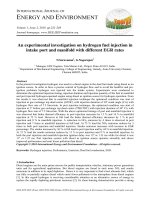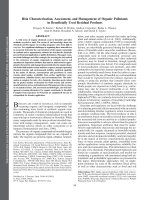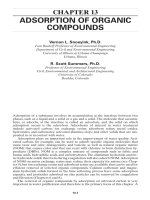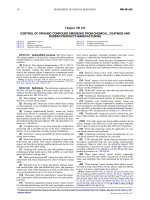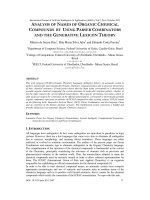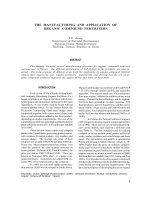heats of hydrogenation experimental and computational hydrogen thermochemistry of organic compounds
Bạn đang xem bản rút gọn của tài liệu. Xem và tải ngay bản đầy đủ của tài liệu tại đây (7.34 MB, 234 trang )
HEAT
HYD
£8
Experimental and
Computational Hydrogen
Thermochemistry of
Organic Compounds
Donald W. Rogers
Experimental
and
Computational Hydrogen
Thermochemistry
of
Organic Compounds Experimental and
Computational Hydrogen
Thermochemistry of
Organic Compounds
Long Island
University,
USA
lip World Scientific
NEW JERSEY
•
LONDON
•
SINGAPORE
•
BEIJING
•
SHANGHAI
•
HONGKONG
•
TAIPEI
•
CHENNA
Published by
World Scientific Publishing Co. Pte. Ltd.
5 Toh Tuck Link, Singapore 596224
USA office: 27 Warren Street, Suite 401-402, Hackensack, NJ 07601
UK office: 57 Shelton Street, Covent Garden, London WC2H 9HE
British Library Cataloguing-in-Publication Data
A catalogue record for this book is available from the British Library.
HEATS OF HYDROGENATION
Experimental and Computational Hydrogen Thermochemistry of Organic Compounds
Copyright © 2006 by World Scientific Publishing Co. Pte. Ltd.
All rights
reserved.
This
book,
or parts
thereof,
may not be reproduced in any form or by any means,
electronic or
mechanical,
including
photocopying, recording or any information storage and retrieval
system now known or to be
invented,
without written permission from the Publisher.
For photocopying of material in this volume, please pay a copying fee through the Copyright
Clearance Center, Inc., 222 Rosewood Drive, Danvers, MA 01923, USA. In this case permission to
photocopy is not required from the publisher.
ISBN 981-256-954-5
Printed in Singapore by World Scientific Printers (S) Pte Ltd
Dedicated to the memory of Frank McLafferty
Scholar, Teacher, Friend
He maketh me to lie down in green pastures
Psalms 23
Hydrogen thermochemistry consists of obtaining useful thermodynamic
information by measuring the heat output upon adding hydrogen across
the double or triple bond or bonds of an unsaturated organic molecule.
Though far less general in its application than combustion
thermochemistry, it is simpler and it produces results of comparable
accuracy. Heats of hydrogenation constitute a body of thermochemical
information that has had a historical significance far out of proportion to
the small number of research groups that have engaged in the work.
Early studies (1935-1939) by Kistiakowski and coworkers at Harvard
produced some of the most widely quoted results in all of
thermochemistry, among them the conjugation energy of 1,3-butadiene
and the resonance energy of benzene. After an initial, highly productive
period, however, hydrogen thermochemistry was cut short by World War
II,
and it languished until the late 1950s, largely because chemists
favored the vastly more general competing method of oxygen bomb
calorimetry.
Recent highly accurate quantum mechanical calculations requiring
reference standards of comparable accuracy and the economics of fuels
and petrochemicals have brought hydrogen thermochemistry back into
contemporary focus. There is at present no critical survey of the scattered
literature on experimental methods and results of hydrogen
thermochemistry, or the burgeoning field of computational hydrogen
thermochemistry. This short monograph is intended to fill that gap. It is
divided into three chapters, each covering a distinct part of hydrogen
thermochemistry:
Vll
Vlll
Heats of Hydrogenation
1.
Practical
and
historical aspects
of
experimental determination
of
the
enthalpies
of
hydrogenation
and
formation
\
yd
H
29S
and
A
f
H
29i
of
organic compounds, primarily hydrocarbons, are given
in
Chapter
1.
2.
Chapter 2 consists
of
a
large table containing more than 500
A
h d
H
29S
values measured over
70
years
of
research,
now
scattered throughout
the literature
in
English and
in
German. One
of
the
unusual aspects
of
this literature
is
that contemporary experimental advances, though
they have brought about
an
increase
in
sensitivity measured
in
orders
of magnitude, they have
not
brought about
a
significant change
in
accuracy. Thus the older literature contains results that are
as
valuable
today as they were when they were first published. Like
all
literatures,
however,
the
hydrogen thermochemical literature varies
in
accuracy
and reliability, both of which are commented upon within this table.
3.
Contemporary advances
in
computer hardware
and
software have
brought about
a
immense increase
in our
ability
to
calculate
(as
distinct from measuring) A
hyd
//
298
. Modern computational
thermochemistry includes various empirical, semiempirical,
and
quantum mechanical methods
for
calculating
A
h d
H
m
of
linear
and
cyclic alkenes, polyalkenes, alkynes
and
polyalkynes. There
is at
present
no
critical survey
of
computational methods
for
determining
A
hyd
//
298
which Chapter 3 supplies.
Whatever technological problems
and
successes
the
future
may
bring,
we can be
assured that they will
be
within
the
framework
of
classical thermodynamics.
The author wishes
to
acknowledge
the
help
and
encouragement
of
colleagues
and
friends Joel Liebman, Nikita Matsunaga,
and
Andreas
Zavitsas.
As
always,
I
express my thanks
to
Tony Zeru
Li for
extracting
me from the computational problems
I
have created
for
myself in writing
this book.
Greenwich Village NY Donald W. Rogers
Contents
Preface vii
1.
Hydrogen Thermochemistry
1.1 Definitions 1
1.2 History 6
1.3 Theory and Methodology 8
1.3.1 Correction to the gaseous state 12
1.4 Accuracy 15
1.5 Applications 15
1.6 Details of Calorimeter Construction 17
1.7 Design Modifications 21
2.
Experimental Results
2.1 Enthalpies of Hydrogenation 23
3.
Computational Thermochemistry
3.1 Introduction to Computational Thermochemistry 153
3.2 Molecular Modeling 155
3.3 Additivity Methods 159
3.3.1 Bond additivity 159
3.3.2 Group additivity 163
3.3.3 The thermochemical database 166
3.4 Molecular Mechanics 168
3.5 Molecular Orbital Calculations 172
3.6 Semiempirical Methods 176
3.6.1 The Huckel method 176
3.6.2 Higher semiempirical methods 181
ix
x Heats of Hydrogenation
3.7 Ab initio Methods 182
3.7.1 The Gaussian basis set 183
3.7.2 Post Hartree-Fock methods 185
3.7.3 Combined or scripted methods 186
3.7.4 Finding
A
(
H
29i
and
\
yi
H
m
from G3(MP2)
results 189
3.7.5 Variation of A
hyd
#
298
with T 191
3.7.6 Isodesmic reactions 193
3.7.7 Ionization potentials, proton affinities and electron
affinities 197
3.7.8 Density functional theory (DFT) 199
3.7.9 Complete basis set extrapolations (CBS) 201
3.7.10
Bond dissociation energies 202
Bibliography 207
Index 219
Chapter 1
Hydrogen Thermochemistry
Historically, experimental heats of hydrogenation have had an
importance far out of proportion to the small number of research groups
engaged in their measurement. Much of our quantitative understanding
of such concepts as resonance, conjugation, aromaticity and
antiaromaticity, molecular strain, and the more subtle aspects of
molecular stability arose from hydrogenation experiments. For examples
from the work of the six principal research groups in the field, see
Conant and Kistiakowsky (1937), Williams (1942), Skinner (1959),
Turner et
al.
(1973), Roth et
al.
(1991), and Rogers et
al.
(1998).
1.1 Definitions
When hydrogen is added across a carbon-carbon double or triple bond
H H
\ y ii
a measurable amount of heat is given off to the surroundings owing to a
decrease in energy and enthalpy of the system. For a reaction carried out
at constant pressure, the heat out is equal and opposite to the enthalpy
change of the system AH. From the vast field of hydrogenation
chemistry, we shall concentrate almost exclusively on the
thermochemistry of simple hydrogen addition to unsaturated
hydrocarbons in this work. Hydrogenation of unsaturated hydrocarbons
always gives off heat, hence the molar enthalpy change of hydrogenation
A
hyd
//
298
is always negative.
1
2
Heats of Hydrogenation
The molar enthalpy of formation A
{
H of any substance is the
change in enthalpy that takes place when elements combine to form one
mol of that substance by a formation reaction, real or hypothetical
Elements
—>
Compound
In the case of hydrocarbons, the formation reaction is
mC +
|H
2
^C
m
H
n
. (1.1)
It is possible to determine the energy change of any well defined
chemical reaction A
t
U carried out at constant volume by measuring the
heat given off to or absorbed from the surroundings by suitable
calorimetric means. (Heat absorbed increases the energy of the system
making A
r
U positive.) If a substance is burned at constant volume V,
one speaks of its "heat" of combustion A
C
U and if a hydrogenation is
run at constant pressure P, one speaks of its heat of hydrogenation,
meaning its A
h d
//
298
. Energy and enthalpy are related by the well-
known definition H
=
U
+
PV.
If the reactants and products of a formation reaction are in their
standard states, the enthalpy change is a standard enthalpy of formation
A
f
r/
29g
mC(gr)
+
-H
2
(g,/> =
0.1
MPa) ->C
m
H
n
(stable form) (1.2)
where (gr) designates the graphitic form of carbon and the stable form of
the hydrocarbon is a gas (g), liquid (1) or a solid (s) according to the
temperature. The unit of pressure is the pascal Pa = Nm'
2
, where 10
5
Pa =
1 bar = 1 atmosphere. If the reaction is carried out at or corrected to a
standard temperature of
298
K (strictly defined as 298.15 K) the symbol
A
f
//2
98
i
s use<
^- See Klotz and Rosenberg (2000), especially Table 4.1
for a more detailed discussion of standard states. An enthalpy change
measured at or corrected to 298 K but not under strict standard state
conditions is denoted A//
298
. Each enthalpy change, A
f
//2
9g
and
A
hyd
//
298
, is a special case of the less restricted
AH
29i
.
A reliable A
h
d
H
29i
and a reliable enthalpy of formation A
f
//
298
of
either the reactant or the product of hydrogenation leads to A
f
//
29g
of the
Hydrogen Thermochemistry
3
other participant in the reaction because A
{
H°(H
2
) - 0 at 298 K and 10
5
Pa by definition.
A
M^29g =
A
f
^298
(product) - A
f
H
29i
(reactant)
-A
(
H°
m
(H
2
).
(1.3)
0
Frequently, the
A
{
H
29i
of an alkane is accurately known but A
f
//
29g
values of one or more of the several alkenes or alkynes that can be
hydrogenated to it are not known. The hydrogenation experiment then
yields A
f
//
298
(alkene or alkyne)by Eq. (1.3). A simple example is that
of the isomeric linear hexenes, hexadienes, and 1,3,5-hexatriene, all of
which can be hydrogenated to give «-hexane. Conditions are usually
such that A
f
H calculated from hydrogenation data is very close to the
enthalpy of formation of
the
alkene in the standard state A
{
Hl
9i
. A less
usual situation is determination of the
A
f
H
29i
of the product alkane by
combining
A
hd
H
29S
with the known
A
f
H
29i
of
an
alkene.
Partial heats of hydrogenation that are not directly measurable can be
obtained from total heats of hydrogenation by an indirect calculation.
H,
1,3-butadiene
1-butene
(1.4)
The hydrogenation of 1,3-butadiene to
1-butene
cannot be carried out
quantitatively but we know the total heats of hydrogenation at 355 K of
both components to give ^-butane as the product (Conant and
Kistiakowsky, 1937).
2H
2
-57.1
(1.5a)
+
H-
•2
-
303
' " (1.5b)
4 Heats of Hydrogenation
-26.8 /
-30.3
Fig. 1.1 A thermochemical cycle of hydrogenation reactions.
These results (both in kcal mol"
1
, Chap. 2) permit one to construct a
thermochemical cycle with one unknown A
h d
H , shown in Fig. 1.1 as a
dashed arrow. By the first law of thermodynamics, the closed path
around the cycle has AH = 0 , so
A
hyd
#
355
(l,3-butadiene) = -57.1 -(-30.3) = -26.8 kcal mol"
1
. (1.6)
It is not always necessary to have an accurate
A
f
H
29S
for the
product alkane. For example, if the A
f
i/
298
(alkane) in Fig. 1.1 were
unknown or thought to be unreliable, calculation of A
f
//
29g
(1,3-
butadiene) and A
f
//
298
(1-butene) would be suspect but A
h d
//
29g
of the
difference between them, which is the partial reaction of 1,3-butadiene to
1-butene,
would still be valid. In this way Kistiakowsky (Conant and
Kistiakowsky, 1937) found the enthalpy of isomerization of cis- to trans-
2-butene to be negative {trans more stable than cis) and to have
A
isom
H
i55
=-0.95 ±0.14 kcal mol"
1
. See also Turner and Garner (1957)
for an analogous determination of the enthalpy difference between exo-
and endo-cyclic double bonds.
No one has ever claimed that hydrogen thermochemistry will replace
combustion thermochemistry but, as Kistiakowsky pointed out in his first
paper on the subject (Kistiakowsky et al., 1935), reaction thermo-
chemistry, despite its lack of generality, is a powerful tool because it can
be expected to yield more accurate enthalpies of formation than
combustion thermochemistry for some molecules under some
circumstances. Reaction thermochemistry, especially hydrogen
-57.1
Hydrogen Thermochemistry
5
thermochemistry, is particularly well suited for determination of small
energy differences between large molecules.
Hydrogenation thermochemistry has been effective in quantitative
evaluation of quantum mechanical effects and molecular strain, for
example, resonance stabilization of aromatic compounds, conjugative
stabilization of linear polyenes and polyynes, and steric effects in cis-
and trans- isomers. Kistiakowsky's measurement of A
hyd
H of benzene
(Conant and Kistiakowsky, 1937) gave the first experimental,
quantitative value of the resonance energy of benzene, long known
qualitatively through its reluctance to add bromine across the presumed
double bonds of its Kekule structure, and given a quantum mechanical
rationale by Huckel in 1931 and by Pauling in 1933. The first
quantitative measure of conjugation, hyperconjugation, and strain in
organic molecules arose from Kistiakowsky's determination of the
differences in A
hyd
// among alkenes and between monoalkenes and
dienes (Conant and Kistiakowsky, 1937).
Recent advances in computational chemistry have made it possible
to calculate enthalpies of formation from quantum mechanical first
principles for rather large unsaturated molecules, some of which are
outside the practical range of combustion thermochemistry. Quantum
mechanical calculations of molecular thermochemical properties are, of
necessity, approximate. Composite quantum mechanical procedures may
employ approximations at each of several computational steps and may
have an empirical factor to correct for the cumulative error. Approximate
methods are useful only insofar as the error due to the various
approximations is known within narrow limits. Error due to
approximation is determined by comparison with a "known" value, but
the question of the accuracy of the "known" value immediately arises
because the uncertainty of the comparison is determined by the
combined uncertainty of
the
approximate quantum mechanical result and
the standard to which it is compared.
Once the validity of a quantum mechanical procedure has been
established by its ability to reproduce various accurate experimental
results, the way is clear to calculate unknown thermochemical values of
unstable or explosive compounds, unsuited to classical thermochemical
methods, or to calculate thermochemical properties of molecules,
radicals, or ions of fleeting existence (e.g., Zavitsas, Matsunaga, and
6
Heats of Hydrogenation
Rogers, 2005). Herein lies a major advantage of the accuracy inherent
hydrogen thermochemical results and a reason for renewed interest in the
diverse but scattered literature devoted to hydrogen thermochemistry.
Parts 1 and 2 of this work are devoted to experimental hydrogen
thermochemistry while part 3 treats the emerging field of computational
hydrogenation thermochemistry.
1.2 History
In 1935, Kistiakowsky's group (Kistiakowsky et al, 1935) published the
first of a series of papers on the experimental determination of A
h
.H of
51 hydrocarbons containing from 2 to 10 carbon atoms. They pointed
out that, while experimental measurement of the energy of combustion
A
c
C/
is generally more precise than A
h
.H measurement, arriving at the
desired enthalpy of formation A
f
//
29g
, through A
h d
//
298
may be more
accurate because A
hyd
//
298
is much the smaller number. Thus A
C
U
values increase monotonically with the number of carbons and the
molecular weight but
A
hyd
H
29S
for monoalkenes, for example, do not.
At the time of Kistiakowsky's first paper, many extant
thermochemical results had been measured in the nineteenth century and
are now of archival interest only. Using these data, Kistiakowsky
observed that it was impossible to calculate the magnitude or, in some
cases,
even the sign of energy differences resulting from small changes
in molecular structure. This motivated an investigation into hydrogen
thermochemistry by which the Kistiakowsky group determined A
hyd
//
298
at a level of precision of about ±0.1 kcal mol"
1
. For example, they found
A
hyd
//
298
for cis- and trans-2-butene to be -28.33 ±0.10 and
-27.38 ±0.10 kcal mol"
1
respectively, leading to the isomerization
enthalpy A
isom
//
298
- -0.95 ±0.14 kcal mol"
1
and showing that the trans
isomer is the more stable of the two. This was confirmed in 1951 by
accurate combustion thermochemistry. Prosen, Maron et al. found
A
c
H
=
-647.65 ±0.29 kcal mol"
1
and A
c
H
=
-646.90 ±0.23 kcal mol"
1
respectively, for the two isomers leading to A
isom
//
298
= -0.75 ±0.37
kcal mol"
1
, the difference between them. Even in this simple case, the
combustion results must be 28 times as precise as the hydrogenation
results to achieve the same precision in the enthalpy difference. A similar
Hydrogen Thermochemistry
7
calculation for Cg monoalkenes would require a precision ratio of
56:1,
C12
requires a ratio of
84:1
and so on.
The series of papers written by Kistiakowsky in the late 1930s is
arguably the most influential group of research papers ever published on
the relationship between experimental thermochemistry and molecular
structure, for it contains the first quantitative assessment of the energetic
influence conferred upon molecules by the structural features
conjugation, hyperconjugation, aromatic resonance, and molecular strain.
Later, antiaromaticity and homoaromaticity were added to this list. These
structure-energy relationships are referred to directly or indirectly in
most elementary organic chemistry textbooks to this day.
Kistiakowsky's work was cut short by World War II, to be taken up
briefly by Williams (1942), who carried out the first accurate A
hyd
//
29g
measurements made in solution. Though the rationale of hydrogen
thermochemistry was investigation of relatively large molecules, the gas-
phase method used by Kistiakowsky had pretty nearly reached its limit in
size because larger molecules are not volatile enough to be hydrogenated
under the conditions he used. The change-over from gas-phase
thermochemistry to solution thermochemistry was inevitable if hydrogen
thermochemistry was to move in the natural direction, that is, toward the
study of larger molecules and molecules less volatile than hydrocarbons.
Solution hydrogenation does not suffer restrictions due to volatility and
can be carried out, in principle, at any temperature. As an added
complication, however, solvent interactions with both reactant and
product may influence the measured
A
hyd
H
29g
.
These influences were
treated in detail by Williams (1942).
Following Williams' work, Skinner's group published 3 papers in
the late 1950's (Skinner, 1957). Skinner's work is noteworthy for its
exploration of intramolecular energetic interactions of alkynes.
Starting contemporaneously with Skinner, Turner's group (Turner
et al., 1957) published a much larger body of work ending in 1973.
Turner's work produced a substantial amount of data on the relative
stability of isomers, for example, exo-endo isomers like methyl-
cyclopentene and methylenecyclopentane.
More recent work in hydrogen thermochemistry has been by the
groups of Roth (1983) and of Rogers (Bretschneider and Rogers, 1970).
Typically, work of the Roth group is characterized by numerous
8 Heats of Hydrogenation
measurements on structurally interesting molecules, high accuracy
(typically ±0.5 kJ = ±0.1 kcal mol"
1
), and careful correction for small
residual solvent effects.
The method we presently use (Caldwell et al, 1997, Rogers et al,
1998) is not as accurate as the best results obtained by the methods
above, but it is very sensitive. Within accuracy limits that are never
better than + 0.8 kJ mol"
1
= + 0.2 kcal mol"' (Rogers and Crooks, 1983)
and may be as high as + 4 kJ mol"
1
, we can, in favorable cases, carry out
a complete series of
A
hyd
H
29S
determinations on a drop of liquid
hydrocarbon. Because the molecules one is most interested in are often
unstable, difficult to prepare, and difficult to purify (e.g., Rogers et al.,
1978),
this can be a significant advantage.
1.3 Theory and Methodology
Kistiakowsky's apparatus was a flow calorimeter. A mixture of gaseous
alkene or alkyne and hydrogen flowed into a reaction chamber filled
with finely divided copper catalyst. The reaction product plus heat
flowed out of the chamber through a helical glass tube connected to a
suitable collection device. The purpose of
the
helical tube was to convey
the heat of reaction to the calorimeter fluid in which the entire reaction
system was immersed. Upon reaching a steady state, the amount of heat
produced per unit time was measured by the rise in temperature of the
calorimeter fluid. The amount of product alkane transferred to the
collection device per unit time was also measured. This gave the heat of
reaction per mol of reaction product collected. Calibration was by means
of
a
low-voltage electrical heating coil.
Aside from its originality, Kistiakowsky's work is especially
impressive in his anticipation of error sources and experimental
problems and in the ingenious methods he used to circumvent them or to
demonstrate that they had a negligible effect on the final result. In their
first paper, the Kistiakowsky group reported results for over 30 full
hydrogenation experiments on ethylene. Their final average was
A
h d
//
3
8
55
=-32.824 ±0.050 kcal mol"
1
, where the notation designates
reactants and products in the gaseous state at 355 K, reported by
Kistiakowsky as
82°
C.
Kistiakowsky also calculated A
h d
H^ =
Hydrogen Thermochemistry
9
-31.000
+
0.150, A
hyd
//
2
8
73
=-32.460 ±0.050, and A^,=
-32.575 ±0.050 ±0.050.
Almost all of Kistiakowsky's further studies were carried out at
355 K and some concern has been expressed in the literature that the
difference between A
hyd
//
355
and A
h d
//
298
might invalidate or at least
diminish the usefulness of
his
results. This difference appears to be quite
small, however. The change in constant pressure heat capacity, AC
P
, for
a reacting system
alkene + H
2
—>
alkane (1.7)
consists of the difference in C
p
for the alkane and that of
the
alkene plus
C
p
(hi
2
). The C
P
difference between two hydrocarbons is generally
quite small, that of the alkene being slightly less than that of the alkane.
The difference is partly made up by C
P
(H
2
), so the change in heat
capacity brought about by going from the reactant system to the product
is small and the change in enthalpy of reaction with temperature is
correspondingly small. The AC
P
AT contribution to
A
hyd
H
29S
over the
temperature range specified is probably not larger than 0.25 kcal mol"
1
(1.0 kJ mol"') per mole of hydrogen consumed in reaction 1.7. This
upper limit is calculable from the ethylene data above, because the
difference in C
p
is larger for the ethylene-ethane pair than it is for the
other hydrocarbon pairs studied by the Kistiakowsky group.
Williams (1942) gave details of the design of the first hydrogen
calorimeter constructed specifically for measurements of A
h
d
H
302
in
solution. It was a fairly conventional reaction calorimeter in which the
reaction took place in a Dewar flask, but it was made more complicated
by the necessity of maintaining the entire system under hydrogen-tight
conditions. The sample was contained in a glass ampoule broken by an
externally controlled mechanical device to initiate the reaction. The
temperature was 302 K, negligibly different as far as this work is
concerned from 298 K. Difficulties with different choices of solvent and
catalyst were discussed and eventually glacial acetic acid and Pd were
selected. We shall discuss solvent effects in Sec. 1.3.1.
The design used by Skinner's group entailed a reaction vessel
agitated by vertical oscillation within a conventional Dewar flask.
Reaction times were 10-20 minutes as contrasted to several hours
10
Heats of Hydrogenation
reaction time in the Williams calorimeter. The solvent was glacial acetic
acid and the catalyst was reduced PtO. Oscillatory calorimeters have not
found favor since this work.
Turner's calorimeter was a modification of the Williams design
using rotary stirring and catalyst introduction into the reaction mixture
by breaking an ampoule. Turner notes a discrepancy between his results
and those of Kistiakowsky for the test compound
1-heptene
but does not
mention the solvent effect. Turner also points out that the discrepancy is
larger for polyenes than it is for monoenes, becoming quite substantial,
viz 2.3 kcal mol"
1
in the case of cycloheptatriene. Turner's group
produced a large amount of excellent thermochemistry but it is
regrettable that the solvent corrections necessary to convert their results
to the gas phase (see below) were not quantitatively accessed. Careful
measurements of solvent effects are a salient feature of Roth's
hydrogenation studies described below.
We noticed early in our study of hydrogenation thermochemistry
(Rogers and McLafferty, 1971) that glacial acetic acid, the solvent of
choice at that time, is not necessary to achieve a useful reaction rate for
small samples in the presence of large amounts of activated catalyst. We
carried out our work using hydrocarbon solvents as the calorimeter fluid.
Hydrocarbon solvents show much reduced solvent effects and have the
added advantage of lower heat capacity than acetic acid, thus amplifying
the thermal signal AT. The sample, in the form of
a
dilute solution in the
same hydrocarbon as that chosen as the calorimeter fluid, was injected
by means of a microsyringe. Very small samples and large amounts of
activated catalyst in the reaction slurry reduced reaction times by 100
fold from the previous minimum to about 10-20 s. With such short
reaction times, we chose to operate our microcalorimeter in isoperibol
mode, that is, we made no attempt to maintain strictly constant
temperature except that conditions were manipulated such that the
temperature drift before and after reaction was not steep. Injection of a
sample caused a typical sigmoidal temperature vs. time curve from
which the temperature rise for the reaction was interpolated in the usual
way (Rogers and Sasiela, 1973). In later versions of the calorimeter,
these curves were stored in microcomputer memory and interpolated
digitally (Fang and Rogers, 1992). Calibration of the thermal rise and
Hydrogen Thermochemistry
11
conversion to conventional enthalpy units was by comparison to the
thermal rise of a "known" such as
1-hexene
or cyclohexene.
In this method, corrections are not made for the transfer enthalpy
from solution to the gaseous state on the ground that solute molecules in
very dilute solution with a noninteracting solvent are essentially
independent of one another and mimic the ideal gas state. This
assumption has been questioned but the results are confirmed by
meticulous combustion experiments where they exist (Steele et al, 2002)
and by high level computational values (Rogers, et
al.,
2004).
Roth (1980) developed a hydrogenation method which also uses
alkane solvents, thus minimizing solvent interaction. His calorimeter is a
very accurate commercial isothermal titration calorimeter (Christensen
et al., 1973) and in his initial paper, he compared results with literature
values for five olefins. The reaction vessel was maintained at constant
temperature before, during, and after addition of a titer of dilute olefin
solution by means of a motor-driven precision microburet. Constant
temperature was maintained by means of a constant rate Peltier cooler
operating in opposition to a variable heater. The heater delivered a
number of fixed energy pulses to the reaction vessel controlled by a
circuit with a thermistor inside the vessel. During the titration, heat
generated or absorbed within the vessel disturbed the balance between
the heating and cooling devices and the number of pulses delivered to the
heater changed in response to the control circuit. At the beginning of
the titration, a sharp change in the number of pulses was recorded and at
the end, a change in the opposite direction was recorded. The size of the
step function was proportional to the enthalpy change within the reaction
chamber. This was converted to conventional enthalpy units by
calibration against the heat output from a "reference" resistance heater.
An advantage of this ingenious arrangement is that optimum precision
could be obtained by adjusting either the voltage to the reference heater
or the speed of the microburet so that the size of the hydrogenation or
solution plateau (or depression) was equal to that of the reference
plateau.
In his initial paper, Roth used acetic acid, methanol, and cyclohexane
as solvents and Pd over carbon support, Pt/C, Pt, Pd/BaS0
4
, and Pt0
2
.
He settled on Pd/C and cyclohexane as optimal. Precision and agreement
with Kistiakowsky's results were in the region of 0.1-0.2 kcal mol"
1
.
12
Heats of Hydrogenation
1.3.1 Correction to the gaseous state
Most contemporary molecular mechanical
or
quantum mechanical
calculations give the properties
of
a single molecule isolated from all
others, that is,
a
molecule
in
the ideal gaseous state. Over the years,
enthalpies of hydrogenation have been measured by several experimental
strategies using a variety of
solvents.
Only Kistiakowsky's early work on
relatively small molecules involved hydrogenation in the gaseous phase.
For reasons of limited vapor pressure of substances of current interest,
his methods are unlikely to be used again.
Given that some sort of solution thermochemistry is necessary, one
must either make the corrections outlined by Williams (1942) and Fuchs
and Peacock (1979) or make use of uncorrected or partially corrected
data with
an
awareness
of
the enthalpic corrections that have been
ignored.
Fuchs and Peacock (1979) give the thermodynamic cycle
alkene(g)
A
W
H
fe)
»
a
i
kane(g)
I AH(y -» S)
I
-AH(v -> S)
alkene(soln)
•
alkene(soln)
where (g) denotes the gas phase,
\
yd
H
is the uncorrected enthalpy
of hydrogenation measured
in
solution, and AH(v
—»
S)
is the
enthalpy of transfer from vapor to solvent
A//(v^S) = A
soln
//-A
vapJ
rY.
(1.8)
The influence of experimental strategy on the solvent correction
is
seen by contrasting the experiments of Williams with those of Turner's
group. Williams gives the equation
AH=AH-(
x
L
v
-
Y
L
v
)-L
s
(1.9)
Hydrogen
Thermochemistry
13
where L designates the molar "latent heats" of vaporization and solution
respectively, subscripted X denotes the reactant and Y denotes the
product. In the notation we use here, L
v
= A
vap
/7 , L
s
= A
soln
// , and
A
hyd#298 (8)
=
A
hyd
//
~
A
va
P
//
298
(alkene)
+
A
vap
//
298
(alkane)
-A
soln
//
298
(alkane) (1.10)
for the reaction of a liquid alkene to the corresponding liquid alkane
where the temperature is taken to be 298 K. If the reactant and product
are both solids, Williams's Eq. 2 is, in our notation,
A
hyd#298 (g) = \yi
H
~
A
fus^29
8
(alkene)
+
A
&s
//
298
(alkane)
-
A
va
P
#298
(alkene) + A
vap
//
298
(alkane) - A
soln
//
298
(alkane) (1.11)
where
A
fus
H
29S
denotes the enthalpy of fusion of the solid at 298 K.
As a trial case, Williams chose hydrogenation of 1-heptene. He
equilibrated Pt or Pd catalyst in glacial acetic acid under dry H
2
at a
pressure just over ambient. Upon breaking an ampoule containing 1 to
1.5 g (accurately weighed) of 1-heptene, A
hd
H was measured for the
reaction
l-heptene(l) + H
2
(g)
—>
«-heptane (s)
where (1) denotes the liquid state and (s) denotes »-heptane in solution.
The temperature was 302.1 K. Results using Pt catalyst took up more
than one equivalent of H
2
and were deemed unsuitable. The result
obtained for
3
runs using Pd catalyst was
A
hyd
H
=
-28.280 ±0.127 kcal mol'
1
.
The enthalpy of solution of «-heptane in glacial acetic acid was found in
a separate experiment to be 1.436 ±0.006 kcal mol"'. Williams took
enthalpies of vaporization from the literature, obtained by standard
classical thermodynamic means, and corrected them to a temperature of
302.1 K to coincide with his A
hyd
H measurements. This led to a
difference
14 Heats of Hydrogenation
-A
vap
#
302
,
(1
-heptene) + A
vap
//
302
, (rc-heptane) = -0.257 ± 0.152 kcal mol"
1
.
The corrected A
hyd
//
298
(g) is
A
hyd
//
298(g) = -28.280 ±0.127- 0.257 ± 0.152 -1.436 ± 0.006 kcal mol"
1
which leads to A
hyd
//
3021
(g) = -29.973 ±0.255 kcal mol"
1
. This value
was further corrected from 302.1 K to 355.1 K in order to coincide with
Kistiakowsky's measurements. The result was
A
hyd
//
355
,(g) = -30.195 ±0.285 kcal mol"
1
.
This is to be compared to Kistiakowsky's measurement of
A
hyd
//
3551
(g) = -30.137 ±0.037 kcal mol"
1
.
Agreement is well within experimental uncertainty. The uncertainty
in the difference between the two enthalpies of vaporization is largest
and the enthalpies of vaporization contribute least to the result. It is to be
anticipated that these enthalpies will not be known for most compounds
of future interest, and the temperature at which these experiments were
carried out, 302.1 K is closer to the temperature of interest, 298.1 K, so
Williams simply dropped the vaporization and temperature corrections to
obtain A
h d
//
302
,(g) =-29.716±0.133 kcalmol" . The precision of this
measurement is about 0.5% or 0.15 kcal mol"
1
. He estimates the over-all
uncertainty as ± 1.0% = 0.3 kcal mol"
1
.
Turner's experimental strategy leads to a slightly different correction
pattern. In a slight variation in procedure, Turner's group broke the
sample ampoule before a similar catalyst ampoule. They re-equilibrated
the system before breaking the catalyst ampoule and measured the
temperature change. The heat of activation of the catalyst, measured in a
separate experiment, was subtracted from the total measured heat. In this
way, the liquid —> solution reaction of Williams was replaced by a
solution —> solution reaction, partly escaping the thermal effects of
